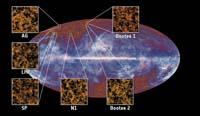Publish the most complete view of the universe

ESA presents the results of the Planck mission
The Planck satellite was sent into space in 2009 to explore the universe at millimeter wavelengths and below millimeter, that is, between infrared and radio waves. Last year astronomers presented the image of the entire area occupied by the telescope and have now released the first data studies.
In the words of ESA, if Shakespeare were currently alive and astronomer, he could say something like this: "The whole universe is a stage, and galaxies, only actors." In fact, galaxies are seen in visible light, but if the life of the universe were a play, they would appear in the last initiative. Planck has known the work from the beginning. In fact, it has collected valuable data to understand the evolution of the universe.

Among the most relevant data is the Early Release Compact Source Catalogue (ERCSC). The catalog collects thousands of radiation sources and is now within reach of all astronomers. Thus, researchers begin to obtain results.
For example, populations of invisible galaxies in visible light surrounded by dust clouds have been detected. They were formed in the first 2,000 million years after the Big Bang, in which the stars were produced at a much higher speed than the current one, between 10 and 1,000 times faster --in the Milky Way a star is created a year, approximately -. The study of these galaxies will serve to understand the formation of the cosmic net.
They have also yielded results on the dark gas of the galaxy. Dark gas is independent of dark matter or dark energy. They are sources of microwave radiation that have concluded that they can be rotating dust clouds.
In addition, Planck has highlighted the beginnings of the universe, giving clues to the first large-scale structures. Planck detects galaxies through microwave background radiation released 380,000 years after the Big Bang.

However, astronomers still have a lot to do. Among other things, they want to analyze microwave background radiation (BMI) to understand inflation. Inflation is known as the time when the universe expanded rapidly and they hope to know when matter arose and how it was distributed.
According to astronomers, from the point of view of microwave background radiation, the results they have presented so far are actually "noise", but now they have the opportunity to discard them and analyze what really interests them. The full background microwave radiation map is expected to be by January 2013.





